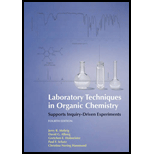
Interpretation:
The reason for the level of elution solvent to not drop below the top of the adsorbent should be determined.
Concept introduction:
Liquid chromatography is used for purification of high boiling compounds. It is known as column chromatography. In liquid chromatography, column is packed by stationary phase. Usually, a solid adsorbent with a liquid coated on it is used as stationary phase. Often a pure liquid or solution of liquids composes the mobile phase. It is also called the elution solvent.
The elution solvent comes down the column under the influence of gravity. Selective interactions are responsible for separation of the sample among stationary and mobile phases. The sequence of elution of compounds from sample depends on the polarity of mobile and stationary phases.
Explanation of Solution
The packing of a column is an important factor for the success of the chromatographic separation in addition to the choice of adsorbent and elution solvents.
If cracks or channels are present in the column or if the top surface is not flat, then separation in the chromatographic column will be poor.
If the adsorbent becomes dry, it may drift away from the walls of the column and form channels. Once a chromatographic separation begins, it is essential to finish it without interruption.
Want to see more full solutions like this?
Chapter 19 Solutions
Laboratory Techniques in Organic Chemistry
- Give the advantages and disadvantages of sequential injection analyzers compared to traditional flow Injection analyzers.arrow_forwardWhy does the efficiency (decreased plate height) of liquid chromatography increase as the stationary phase particle size is reduced?arrow_forwardThin Layer Chromatography. All types of chromatography have mobile phaseand stationary phase. What is a stationary phase and a mobile phase? Elaborate your answer.arrow_forward
- Why do we need to add sand on top of the silica in column chromatography? What could happen if we loaded the sample directly onto the silica with no sand on top?arrow_forward1. Substances that interact more strongly with the mobile phase will tend to elute out more slowly. True or False. 2. Substance A has a longer retention time (tR) than substance B. Therefore substance B will emerge/elute out more quickly. True or False. 3. Which of the following types of liquid chromatography is characterized by separation of chemicals based on their interactions with a biologically related binding agent? Answer options: • Adsorption chromatography • Partition chromatography • Ion-exchange chromatography • Size-exclusion chromatography Affinity chromatography ●arrow_forward
 EBK A SMALL SCALE APPROACH TO ORGANIC LChemistryISBN:9781305446021Author:LampmanPublisher:CENGAGE LEARNING - CONSIGNMENT
EBK A SMALL SCALE APPROACH TO ORGANIC LChemistryISBN:9781305446021Author:LampmanPublisher:CENGAGE LEARNING - CONSIGNMENT Principles of Instrumental AnalysisChemistryISBN:9781305577213Author:Douglas A. Skoog, F. James Holler, Stanley R. CrouchPublisher:Cengage Learning
Principles of Instrumental AnalysisChemistryISBN:9781305577213Author:Douglas A. Skoog, F. James Holler, Stanley R. CrouchPublisher:Cengage Learning Macroscale and Microscale Organic ExperimentsChemistryISBN:9781305577190Author:Kenneth L. Williamson, Katherine M. MastersPublisher:Brooks Cole
Macroscale and Microscale Organic ExperimentsChemistryISBN:9781305577190Author:Kenneth L. Williamson, Katherine M. MastersPublisher:Brooks Cole



